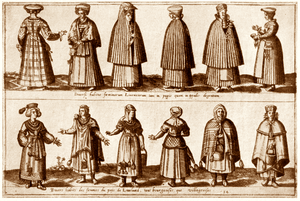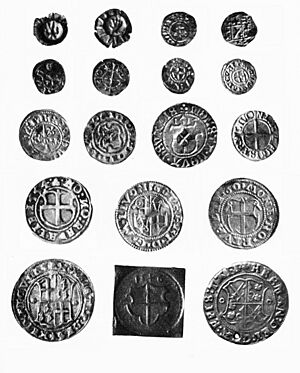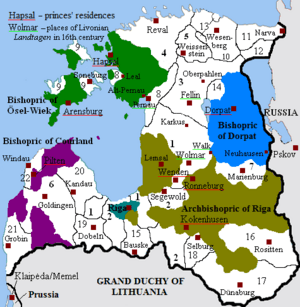Terra Mariana facts for kids
Terra Mariana, also known as Medieval Livonia or Old Livonia, was like a country that existed a long time ago in the Middle Ages. Its lands are now parts of modern-day Estonia and Latvia. It was created after a series of military campaigns called the Livonian Crusade.
Quick facts for kids
Terra Mariana
|
|||||||||||||
|---|---|---|---|---|---|---|---|---|---|---|---|---|---|
| 1207–1561 | |||||||||||||
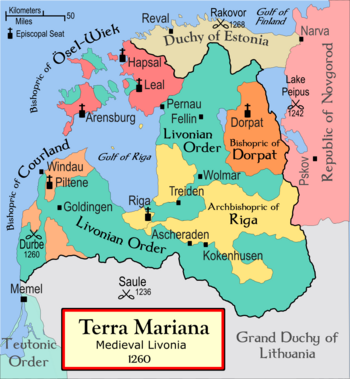 |
|||||||||||||
| Status | Principality of the Holy Roman Empire (1207–1215) Vassal state of the Holy See (1215–1561) |
||||||||||||
| Capital | Riga (de facto) Walk (from 1435) |
||||||||||||
| Common languages | Latin Low German Livonian Estonian Latvian |
||||||||||||
| Religion | Roman Catholicism | ||||||||||||
| Demonym(s) | Livonian | ||||||||||||
| Government | Theocratic elective monarchy | ||||||||||||
| Legislature | Landtag | ||||||||||||
| Historical era | Middle Ages | ||||||||||||
|
• Established
|
1207 | ||||||||||||
| 1343–1344 | |||||||||||||
|
• Landtag formed
|
1419 | ||||||||||||
|
• Confederation Agreement
|
4 December 1435 | ||||||||||||
|
• Treaty of Vilnius
|
1561 | ||||||||||||
| Currency | Artig, Denier, Schilling, Thaler | ||||||||||||
|
|||||||||||||
| Today part of | Estonia Latvia |
||||||||||||
Terra Mariana means "Land of Mary" in Latin. It was officially created on February 2, 1207. At first, it was a principality, which is like a small state, within the Holy Roman Empire. However, in 1215, Pope Innocent III declared it was directly under the Holy See, meaning it was controlled by the Pope.
A special representative of the Pope, William of Modena, divided Terra Mariana into several areas. These included the Duchy of Estonia (which belonged to the King of Denmark), the Archbishopric of Riga, and several bishoprics (areas ruled by bishops). There were also territories managed by a military group called the Livonian Brothers of the Sword. After a battle in 1236, the remaining Brothers joined the Teutonic Order and became known as the Livonian Order. In 1346, the Livonian Order bought the Duchy of Estonia from Denmark.
Throughout its history, there was a lot of fighting for control. Different groups wanted power: the Church, the Livonian Order, German nobles, and the citizens of important trading cities like Riga and Reval (now Tallinn). These cities were part of the Hanseatic League, a powerful group of trading cities.
The Teutonic Order became weaker after a big defeat in the Battle of Grunwald in 1410. But the Livonian Order managed to stay independent. Terra Mariana stopped existing in 1561 during the Livonian War. Its northern parts went to Sweden, forming the Duchy of Estonia. Southern parts became part of the Grand Duchy of Lithuania and later the Polish–Lithuanian Commonwealth, as the Duchy of Livonia and the Duchy of Courland and Semigallia. The island of Saaremaa became part of Denmark.
Since the 20th century, "Terra Mariana" (or Maarjamaa in Estonian) has been a poetic name for Estonia. In 1995, the Order of the Cross of Terra Mariana, a national award, was created to honor Estonia's independence. It is also a poetic name for the Latgale region in Latvia.
Contents
History of Old Livonia
The Livonian Crusade
The lands on the eastern side of the Baltic Sea were among the last parts of Europe to become Christian. In 1193, Pope Celestine III called for a crusade against the non-Christian people in Northern Europe. This crusade was officially announced later, around 1197 or 1198.
In the early 1200s, German crusaders from Gotland and the northern Holy Roman Empire began conquering lands along the Daugava and Gauja rivers. These lands were home to the Livonians and Latgallians. The important city of Riga (the capital of modern Latvia) was founded in 1201. In 1202, the Livonian Brothers of the Sword was formed. This was a military order that helped with the crusades.
In 1218, Pope Honorius III allowed Valdemar II of Denmark to take as much land as he could conquer in Estonia. Albert of Riga, a leader of the crusaders, also asked the German King for permission to attack the Estonians from the North. The last groups to be conquered and Christianized were the Oeselians, Curonians, and Semigallians.
This crusade was different because the Pope allowed people who planned to go on a crusade to the Holy Land to go to Livonia instead. Crusaders in Livonia also wore a special cross symbol, showing they were part of the crusade. After the crusades were successful, the German and Danish-controlled areas were divided by William of Modena.
How Terra Mariana Was Established
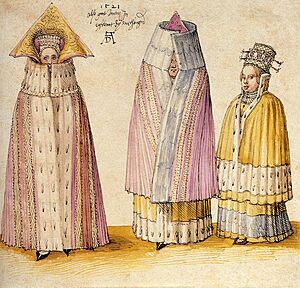
The division of medieval Livonia was set up by the Pope's representative, William of Modena, in 1228. This was a way to find a balance between the Church and the Livonian Brothers of the Sword. Both groups were led by Germans. They had conquered the lands of several local tribes, including the Estonians, Livs, Latgalians, Selonians, Semigallians, and Curonians.
Medieval Livonia was ruled at different times by the Brothers of the Sword, and after 1237, by the Livonian Order. The Roman Catholic Church also had a lot of power. By the mid-1300s, the Livonian Order controlled about 67,000 square kilometers of Old Livonia. They had bought the Duchy of Estonia from Christopher II. The Church controlled about 41,000 square kilometers.
The Order's lands were divided into about 40 districts, each managed by a local official called a Vogt. The largest Church-controlled area was the Archbishopric of Riga, covering about 18,000 square kilometers. Other important Church areas included the Bishopric of Courland, Bishopric of Dorpat, and Bishopric of Ösel-Wiek. The Archbishop of Riga was the main leader of Terra Mariana and the city of Riga.
In 1240, Valdemar II created the Bishopric of Reval in the Duchy of Estonia. He kept the right to choose the bishops of Reval for himself and future Danish kings. This was unusual in the Catholic Church at the time. The right to nominate bishops was even included when the territories were sold to the Teutonic Order in 1346.
Civil Wars in Livonia
Throughout its history, medieval Livonia saw constant power struggles. The Church, the Livonian Order, German nobles, and the citizens of the Hanseatic city of Riga all wanted to be in charge. Two major civil wars happened between 1296–1330 and 1313–1330.
Another important event was the St. George's Night Uprising in 1343–1345. This was a revolt by the Estonians. After the revolt, the Teutonic Order took control of the Danish Duchy of Estonia. The Danish ruler was imprisoned with the help of local German nobles. Castles in Reval and Wesenberg were given to the Order by the German nobility in 1343, and the castle at Narva in 1345. In 1346, the King of Denmark sold the Estonian territories to the Teutonic Order for 19,000 Köln marks. The change of power happened on November 1, 1346.
The Livonian Confederation
The Teutonic Order became weaker after being defeated by Poland and Lithuania in the Battle of Grunwald in 1410. However, the Livonian Order remained independent. This was because they did not take part in that battle and had made a truce with Grand Duke Vytautas.
In 1418, Pope Martin V appointed Johannes Ambundii as the Archbishop of Riga. He helped organize the Livonian confederation. There were often conflicts between the Order, the bishops, and the powerful Hanseatic cities. To solve these problems, the Livonian Diet, or Landtag, met in 1419. This meeting was started by Archbishop Ambundii. The city of Walk was chosen as the meeting place. The Diet included members from the Livonian Order, Livonian Bishops, local nobles (vassals), and city representatives.
On September 1, 1435, the Livonian Order suffered a big defeat in the Battle of Wiłkomierz. Their leader and several important knights died. This made the Order work more closely with its Livonian neighbors. The Livonian confederation agreement was signed in Walk on December 4, 1435. It was signed by the Archbishop of Riga, the bishops of Courland, Dorpat, Ösel-Wiek, and Reval. Representatives of the Livonian Order, local nobles, and city councils of Riga, Reval, and Dorpat also signed it.
The states of the Livonian Confederation ended during the Livonian War (1558–1582). In 1559, the Bishop of Ösel-Wiek and Courland, Johannes V von Münchhausen, sold his lands to King Frederick II of Denmark. The Danish king gave the territory to his younger brother, Duke Magnus of Holstein. Duke Magnus landed with an army on Ösel in 1560.
In 1561, a Swedish army landed in Reval and took control of the northern part of Old Livonia. The Livonian Order was officially ended by the Treaty of Vilnius in 1561. The next year, the Livonian Diet decided to ask for protection from Sigismund II Augustus, who was the King of Poland and Grand Duke of Lithuania. With the end of the last Archbishop of Riga's rule, Riga became a free imperial city. The rest of the territory was divided into two states that were under Polish-Lithuanian rule: the Duchy of Courland and Semigallia and the Duchy of Livonia.
|
|
|
Why the Name Terra Mariana?
According to a historical account by Henry of Livonia, Bishop Albert of Riga spoke to Pope Innocent III in 1215. He wanted to show how important his area was for crusades and its connection to Mary, the Mother of Jesus. He said:
"Holy Father," he said, "just as you continue to care for the Holy Land of Jerusalem, which is the land of the Son, you should also not abandon Livonia, which is the land of the Mother."
This quote shows why the name "Terra Mariana" (Land of Mary) was chosen for Livonia.
See also
- Kingdom of Livonia
- Üxküll (Ikšķile)
- Northern Crusades




